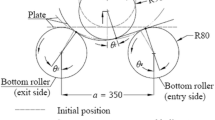Abstract
Roll bending process is an important metal forming process used to produce cylindrical and conical shells and sections for various applications. 3-roller conical bending is one such process. For this process it is important to evaluate the maximum force acting on the rollers during the rolling process for designing the rolling machine as well as for evaluating the coefficient of friction at roller-plate interface. It is observed that maximum force is acting on the roller during the static bending in roll bending process [Gandhi et al. 2008]. In the present study mathematical model for force prediction on the rollers have been developed. Effects of various material properties and geometrical parameters have been studied. It has been concluded that the proposed model can be effectively used to get the roller bending force for given geometrical parameters and material properties. It can also be used to get roller plate interface friction, if the experimental value of roll bending force is available.








Similar content being viewed by others
Abbreviations
- B1, B2:
-
Bearings for top roller
- B3,B4,B5,B6:
-
Bearings for bottom rollers
- w:
-
width of the blank in mm
- t:
-
thickness of the plate in mm
- M:
-
bending moment in N-m
- P:
-
Vertical load at the top roller and bending plate interface in N
- a:
-
horizontal distance of the bottom roller centers in mm
- x:
-
half the horizontal distance of the bottom roller centers in mm
- Q:
-
Normal force exerted by the plate on the bottom roller at roller plate interface in N
- θ:
-
Angle between frictional force and horizontal plane at the roller plate interface in radians
- U:
-
Vertical distance travelled by the top roller for first stage of static bending in mm
- E:
-
Young’s modulus in N/mm2
- K:
-
strength coefficient in N/mm2
- n:
-
strain hardening exponent
- r1:
-
radius of bottom roller in mm
- R:
-
radius of curvature of the bent plate in mm
- y:
-
distance of fiber from neutral plane in mm
- I:
-
Second moment of area (For plate it is equal to bt3/12) mm4
- μ:
-
coefficient of friction at roller plate interface
- ε:
-
strain
- σ:
-
stress in N/mm2
- υ :
-
Poisson’s ratio
- yep :
-
distance of the fiber upto which elasticity E is constant in mm
- χ:
-
curvature of the bend plate between bottom rollers mm−1
- ε*:
-
strain at yield point
- E*:
-
the ratio of modulus of elasticity to σs
- te :
-
thickness of elastic layer in mm
- ε0 :
-
strain of the strip mid-line
- \( \overline \varepsilon \) :
-
effective strain
- \( \overline \sigma \) :
-
effective stress
- β:
-
bottom roller inclination
- AF, AR :
-
Center distance between bottom rollers at front and rear end respectively
- α:
-
top roller inclination in the present case it is zero
- φ:
-
cone angle
- RF, RR :
-
Bending radius at the front end and rear end respectively
References
Hua M, Lin YH (1999) Large deflection analysis of elastoplastic plate in steady continuous four-roll bending process. Int J Mech Sci 41:1461–1483
Gandhi AH, Gajjar HV, Raval HK (2008) Mathematical modelling and finite element simulation of pre-bending stage of three-roller plate bending process, MSEC 2008, doi:10.1115/MSEC_ICMP2008-72454, pp. 617–625
Gandhi AH, Shaikh AA, Raval HK (2009) Formulation of springback and machine setting parameters for multi-pass three-roller cone frustum bending with change of flexural modulus. Int J Mater Form 2:45–57
Wang C, Kinzel G, Altan T (1993) Mathematical modeling of plane-strain bending of sheet and plate. J Mater Process Technol 39:279–304
Hua M, Sansome DH, Baines K (1995) Mathematical modeling of the internal bending moment at the top roll contact in multi-pass four-roll thin-plate bending. J Mater Process Technol 52:425–459
Hua M, Cole IM, Baines K, Rao KP (1997) A formulation for determining the single-pass mechanics of the continuous four-roll thin plate bending process. J Mater Process Technol 67:189–194
Marciniac Z, Duncan JL, Hu SJ (1992) Mechanics of sheet metal forming. Butterworth-Heinemann
Lin YH, Hua M (2000) Influence of strain hardening on continuous plate roll-bending process. Int J Non Lin Mech 35:883–896
Moreira LP, Ferron G (2004) Influence of the plasticity model in sheet metal forming simulations. J Mater Process Technol 155–156:1596–1603
Firat M (2007) Computer aided analysis and design of sheet metal forming processes: Part II – Deformation response modeling. Mater Des 28:1304–1310
Kim H, Nargundkar N, Altan T (2007) Prediction of bend allowance and Springback in air bending. ASME Trans 129:342–351
Gandhi AH (2009) Investigation on machine setting parameters for 3-roller conical bending machine for springback. Ph. D, Thesis, S V National Institute of National Institute of Technology
Sanchez LR (2010) Modeling of springback, strainrate and Bauschinger effects for two-dimensional steady state cyclic flow of sheet metal subjected to bending under tension. Int J Mech Sci 52:429–439
Martin G, Tsang S (1966) The plastic bending of beams considering die friction effects. J Eng Ind Trans ASME 88:237
Hill R (1979) The mathematical theory of plasticity. Oxford University Press
Nepershin RI (2007) Bending of a thin strip by a circular tool. Mech Solids 42–4:568–582
Author information
Authors and Affiliations
Corresponding author
Rights and permissions
About this article
Cite this article
Chudasama, M.K., Raval, H.K. An approximate bending force prediction for 3-roller conical bending process. Int J Mater Form 6, 303–314 (2013). https://doi.org/10.1007/s12289-011-1087-y
Received:
Accepted:
Published:
Issue Date:
DOI: https://doi.org/10.1007/s12289-011-1087-y



